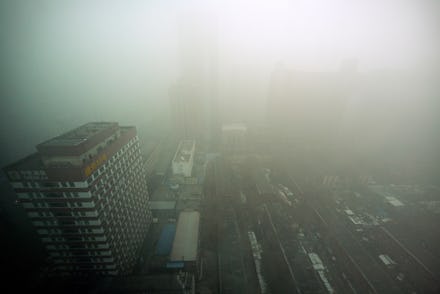Beijing Air Pollution Reaches 'Red Alert' Levels, Closing Schools and Construction Sites

On Monday, for the first time, the government of Beijing ordered a red alert warning for toxic smog.
According to Xinhua News, the warning indicates air pollution will hover at an air quality index of at least 200 for three consecutive days, beginning on Tuesday. Outdoor construction and schools will cease operations, and cars will be restricted from driving on alternate days based on their license plates, Xinhua News reported.
Residents are widely encouraged to stay indoors.
The red alert is the most severe in an air-quality warning system implemented by the Chinese government in recent years, as pollution in much of China's heavily industrialized northeastern region has grown out of control.
Beijing's air quality index has regularly exceeded the 500 maximum on the chart used by the U.S. Environmental Protection Agency, at one time hitting a stunning 755.
The smog is sometimes so thick that it cannot be seen through, and many residents wear respirators or masks in dubiously effective attempts to prevent breathing it.
In 2013, a study concluded air pollution throughout the country resulted in 1.2 million premature deaths in China in 2010. By 2015, another research team working with the environmental nonprofit Berkeley Earth believed the annual death toll was higher, at around 1.6 million people each year or 4,400 a day.
The Berkeley Earth team found 92% of the Chinese population experiences at least 120 hours of pollution that would be considered "unhealthy," reports the Washington Post, with more than one-third of all residents of the country experiencing those unhealthy levels constantly.
The smog is so bad that the Guardian's Oliver Wainwright wrote in 2014 that some days Beijing is virtually "uninhabitable," with entire stretches of the city physically restructured, and daily commutes adjusted to allow inhabitants to live free from smog. At the British School of Beijing, school authorities built an airtight dome to allow students to exercise without breathing in pollution.
According to the Week, the levels of air pollution are due to skyrocketing car ownership, lack of environmental controls, non-enforcement of regulations and China's use of coal to provide 70% of its electrical supply.
China is expected to make a long-term switch away from coal, but in November, the New York Times reported the government was burning 17% or more coal than it had previously publicly acknowledged. Additionally, the large industrial region surrounding Beijing, which includes concentrations of heavy industry in the province of Hebei, is a major source of industrial air pollution separate from the city itself.